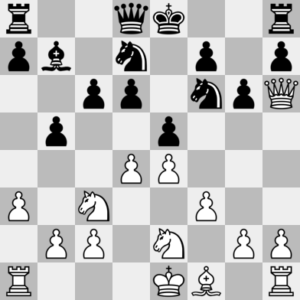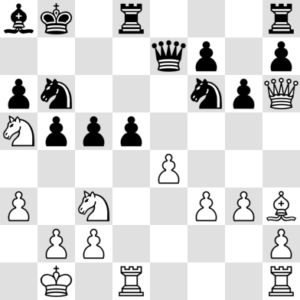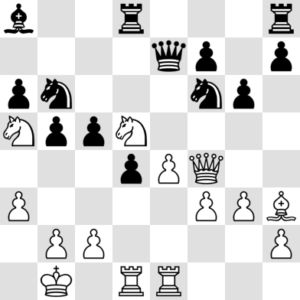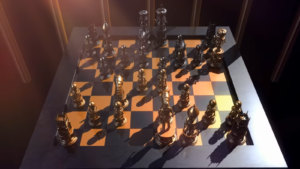After one hundred sixty three blog post, I can apparently still stumble upon something which is novel: I have never written about a DJ before. Yes, an honest to god DJ, proudly riding his vinyl wheels through the airwaves, prodding them on at opportune moments with some precise hand movements. At least that’s what I presume DJ’s are like, I am not exactly an expert in the matter. This particular DJ appeared on the scene back in 2013, when one of his singles even managed to break the Flemish top 10. About half a year later, his third single King was released and broke into the charts in Belgium and France.
That picture is a screenshot from the accompanying music video and, holy shit, it does not look terrible! This seems to be a rather plausible position: the pawn formation it quite normal, where white has more presence in the centre, but black has developed his pieces very well and his position does not have any real weaknesses. Probably, this game started as a 150-attack of the Pirc.
But there’s no reason to speculate:1 we actually see the start of the game. White indeed started with 1.e4 but, surprisingly, black answers 1. … Nf6, not 1. … d6 or 1. … g6. The next move we see is d4 by white, but there are probably some moves cut here, because then we see the position above. It is quite clear in the picture but, for redundancy’s sake, here’s a diagram:2
 Here’s one possibility of how this position could have arisen: 1. e4 Nf6 2. Nc3 d6 3. d4 g6 4. f3 Bg7 5. Be3 c6 6. Nge2 b5 7. a3 Bb7 8. Qd2 Nbd7 9. Bh6 Bxh6 10. Qxh6 e5. There are several more or less plausible alternative move orders.
Here’s one possibility of how this position could have arisen: 1. e4 Nf6 2. Nc3 d6 3. d4 g6 4. f3 Bg7 5. Be3 c6 6. Nge2 b5 7. a3 Bb7 8. Qd2 Nbd7 9. Bh6 Bxh6 10. Qxh6 e5. There are several more or less plausible alternative move orders.
Then things get weird. To start with, this music video uses a non-linear timeline, as we now see black play b5. Then there is an — apparently resurrected — dark-squared white bishop taking a pawn on h6 which immediately reappears again on h7. A white knight takes on b5 at some point, but a moment later the pawn is back and the knight has returned to c3. There are unclear manipulations with queens, pawns, and rooks.
The next clear view we get shows the following position:
 Some remnants of the previous diagram are still clearly recognisable, especially the unusual placement of white’s queen, but considerable changes have taken place. In particular, the e2 knight seems to have made a rather strange tour to end up on a5.
Some remnants of the previous diagram are still clearly recognisable, especially the unusual placement of white’s queen, but considerable changes have taken place. In particular, the e2 knight seems to have made a rather strange tour to end up on a5.
We see white play Qf4+ and moments later are treated to the following sight:
 and finally the whole thing has been utterly derailed. White has played three moves — Qf4, Rhe1, and Nd5 — while black in the meantime has only played d4. Oh, and his king has disappeared.
and finally the whole thing has been utterly derailed. White has played three moves — Qf4, Rhe1, and Nd5 — while black in the meantime has only played d4. Oh, and his king has disappeared.
Noting that their enemy is absent, the white pieces decide to give up and start a rave instead. The white king dons a headphone and starts pumping his right arm, the squares start billowing up and down, the rooks use their battlements as xylophones — madness all around! All this noise brings the black king out of hiding. The moment he appears, in a checkmate on c7 by the way, the white king gets of his pedestal, walks over there, and throws a hadouken — game over.
Realism: 0/5 I found it rather hard to decide what score to give. The positions in the different diagrams are quite believable — with the exception of the black king’s absence in the third one — and it doesn’t seem impossible to get from one diagram to the next, but a missing king is a big strike against the position in terms of realism and there is no way the position with the king on c7 could arise legally, so in the end I gave a 0.
Probable winner: Well, white delivers checkmate. Even if we grant that black’s king could not be on c7 and assume it must have been on b8 he is in trouble, as the f6 knight is about to drop.
1. [Or to analyse the lyrics. There is just a single lyrics, namely “bow to the king”.] ↩
2. [For diagrams worthy of a king, use this editor.] ↩
